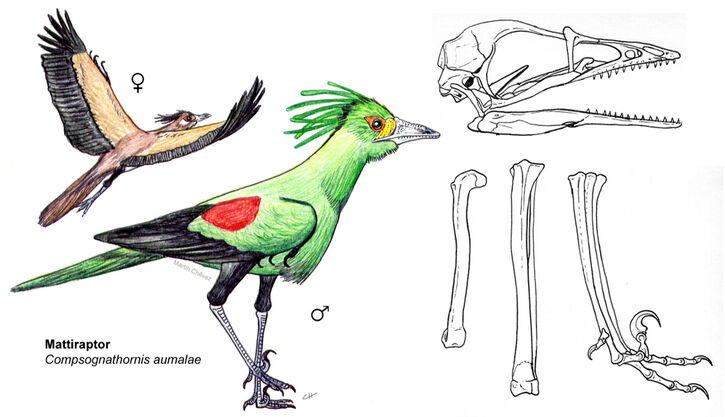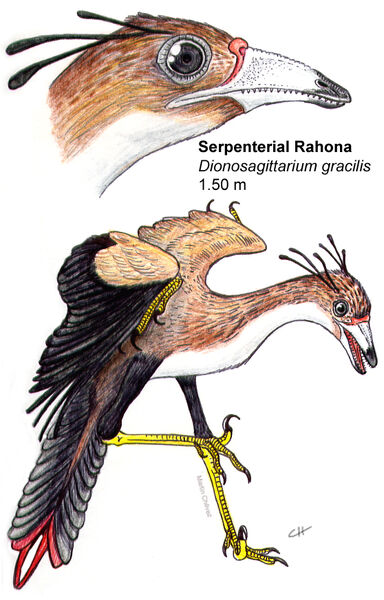INTRODUCTION[]
Madagascar is home to many strange, scaly creatures, from the saber-toothed croctigers to the fleet-footed cains, but amid these antediluvian monsters, there dwell other predators. Small, nimble, and sleekly feathered, the rahonavids look rather like Eurasian draks, but are actually from a different line, an avialan line that is close to the deinonychosaurs some ime during the Jurassic. With weakly stiffened tails and birdlike shoulders, the Malagasy bureaucrat birds are the descendants of Rahonavis, a Late Cretaceous relative of Archaeopteryx. The discovery of this fact has been very fortunate not only for specbiology but also for paleontology,b ecause DNA studies of this group have shown that Rahonavis (and therefore probably Archaeopteryx) is more closely related to dromaeosaurs than to the short-tailed birds.
SPECIES[]
Bureaucratbird (Magistratavis horribilis)[]
The bureaucratbird (Magistratavis horribilis) is what winners look like; its body plan has hardly changed from that of Rahonavis, now 70 million years extinct. On long legs it stalks the Malagasy grassland like a Home Earth secretary bird in search for food, which is mostly comprised of snakes, lizards, unrats, unmice and unbunnies, the smaller Malagasy possums, and big insects. Unlike the poor secretary bird, the bureaucratbird has a snout full of sharply tipped teeth, big claws on all 3 fingers per wing, and an intimidating sickle claw on each 2nd toe. This weaponry allows the bureaucrat to quickly subdue even relatively large prey.
When threatened by a sufficiently big predator, like a lesser stef (see below) or a croclion, bureaucrats normally run away, but if pressed, they are pretty good fliers. They also use their long wings to cross rivers, in their complicated courtship rituals, and to shield their nests from sun and rain.
Lesser Stef (Nesonychus minor)[]
The lesser stef (Nesonychus minor) is a 2-meter long flightless predator that will readily attack anything from the size of a marsupial civet to that of a subadult hoplocroc and will run after honkers, hypsies and alvies if it manages to surprise them. Externally it hardly differs from a drak; it even has serrated teeth. It lives in packs and has communal nests that are fiercely defended.
Greater Stef (Nesonychus major)[]
The greater stef (Nesonychus major) is a rather cryptic forest animal, quite similar to the South American jagular. It is named after its call, which was known long before the animal was first seen. At 4 m in length, the greater stef is the largest member of Rahonavidae. It ambushes honkers and sometimes attacks young sauropods when there are no croctigers nearby. One unconfirmed report says that the males grow long, colorful wing feathers in the mating season, and that the females grow similarly long but more camouflage-colored feathers that are used for brooding (to shield the eggs/young from rain). Unfortunately that particular spexplorer was more interested in croctigers and so sadly died before publishing his findings. However, those findings were recently rediscovered and will be published some itme in the near future.
Flying Mattiraptor (Compsognathornis aumalae)[]
The flying mattiraptor (Compsognathornis aumalae) resembles the bureaucratbird and hunts for similar prey, but lives in the dense rainforests. It flies more seldom than the bureaucratbird and has shorter and more rounded wings. In the mating season the males are covered in magnificent green plumage with a large red spot on each wing.
This species dwells in the dry forests. Generally beige, males developed green iridescent body plumage during the breeding season, developing red dots on their hindwings. Engaging in spectacular acrobatics across the open forest canopy, Green Flying-Mattiraptors are generally terrestrial foragers, hunting more invertebrate prey than their relatives. Females are responsible for the eggs and chicks, the latter leaving the next after a week of life.
Black Flying-Mattiraptor (Compsognathornis marjanovicia)[]
The Black Flying-Mattiraptor (Compsognathornis marjanovicia) occurs in the dense rainforests. Seemingly monogamous with its lack of sexual dimorphism, the Black Flying-Mattiraptor displays a complex system of polyandry, with a single female being the center of a large harem of males that may up to 10 under especially favorable circumstances. The female mates with each individual male from this harem, producing a single egg. After several days this amounts to a clutch of several fathers, all inevitable invested in incubating it and rearing the subsequent chicks. It was thought that this was a system of fraternal polyandry like that displayed by several primates, but a closer inspection revealed that sometimes only as much as 20% of the involved males are closely related.
Alpine Flying-Mattiraptor (Compsognathornis morrisoni)[]
The Alpine Flying-Mattiraptor (Compsognathornis morrisoni) occurs in the montane forests. Black with crimson heads and spots on the wings and tail, this rahonavid lives in small familial flocks, composed of an elder pair and younger dinosaurs that stay around for a year with their parents. These small family units help to fend off competitors from feeding grounds as well as incubating the next generation; the chicks, like in most rahonavids, can find food for themselves, though sticking around the adults definitely increases their chances of survival.
Serpenterial Rahona (Dinosagittarium gracilis)[]
Madagascar is home to many strange, scaly creatures, from the saber-toothed croctigers to the fleet-footed cains, but amid these antediluvian monsters, there dwell other predators. Small, nimble, and sleekly feathered, the rahonavids look rather like Eurasian draks (developed dromaeosaurids), but are actually derived from a different line, one that split from the deinonychosaurs sometime during the Jurassic. With weakly stiffened tails and birdlike shoulders, the Malagasy bureaucrat birds are the descendants of Rahonavis, a Late Cretaceous relative of Archaeopteryx. But specialized that bureaucrat birds, its the Serpenterial Rahona, a variety present in open areas of Madagascar. Of long and stylized paws, these animals hunt a wide variety of small vertebrates that include lizards, mammals, and mainly snakes. They are able to even fly that they don't usually make it, on the other hand, they prefer to travel short distances slowly looking for their prey.
,=(extinct) Rahonavis ostromi
=Rahonavidae=|
| ,=Magistratavis horribilis (Bureaucratbird)
`=|
| ,=Compsognathornis aumalae (Flying mattiraptor)
`=|
| ,=Nesonychus minor (Lesser stef)
`=Nesonychus=|
`=Nesonychus maior (Greater stef)



